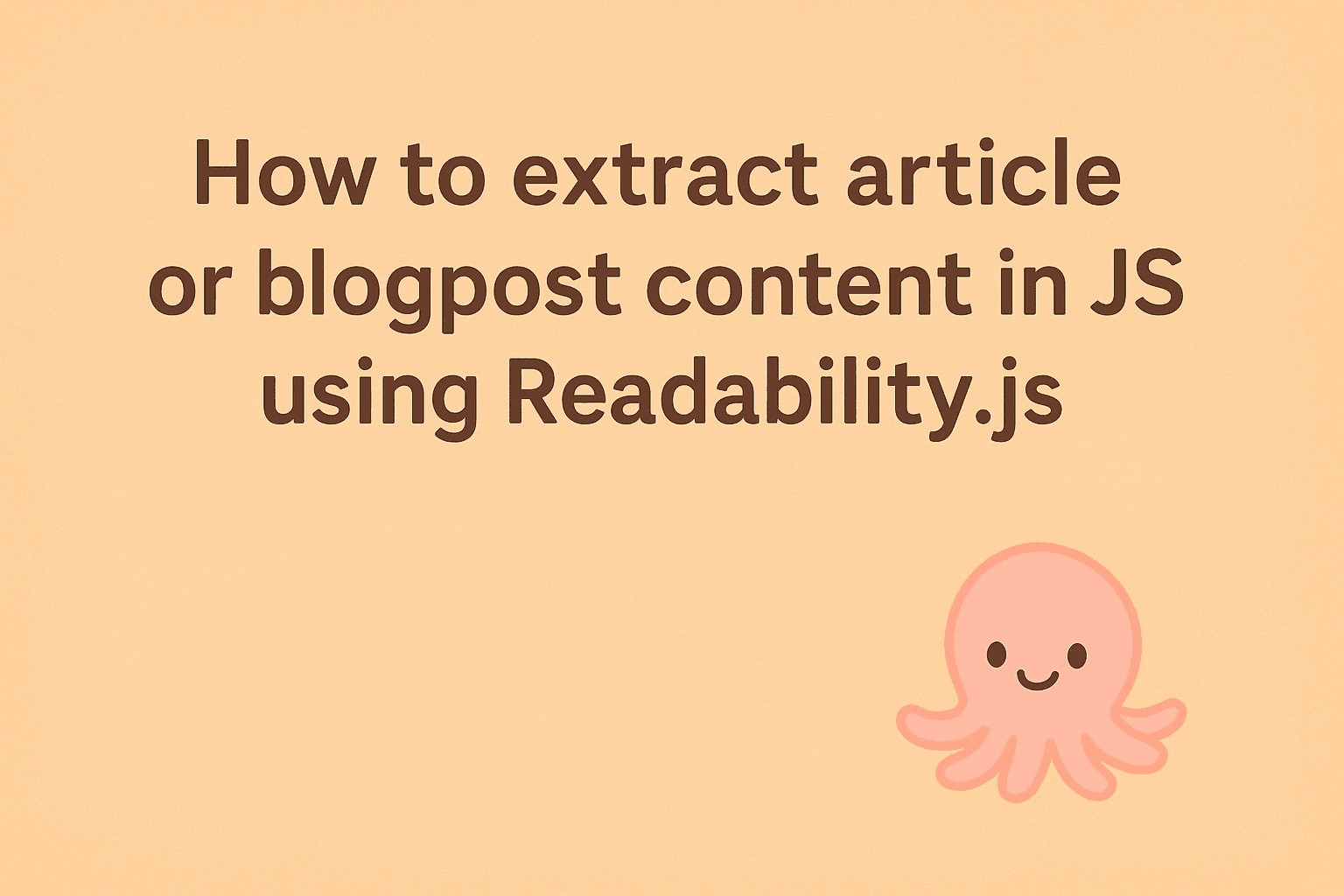Why extracting article content matters
When crawling or scraping articles or blog posts, you often get a lot more than you need. Web pages are packed with navigation menus, sidebars, footers, advertisements, and other elements that aren't part of the main article content. This extra content can create problems:
- Noise in your data: Irrelevant content dilutes the actual information you're trying to extract
- False positives: Search algorithms might match on navigation text instead of actual content
- Larger data size: Storing unnecessary content wastes space and processing power
- Poor AI training: If you're feeding content to language models, unwanted elements can confuse the training process
The solution is to extract only the main article content - the core blog post text and primary information without the surrounding page elements.
Installing readability.js
The easiest way to extract article and blog post content in JavaScript is using Mozilla's Readability library. This is the same algorithm that powers Firefox's Reader Mode.
Install it via npm:
npm install @mozilla/readability
You'll also need JSDOM to work with HTML in a Node.js environment:
npm install jsdom
Removing unwanted HTML elements
Before using Readability, it's often helpful to clean up the HTML by removing elements that are definitely not article content. This improves extraction accuracy and reduces false positives.
Here's how to remove common unwanted elements using a simple cleaning function:
import { JSDOM } from 'jsdom';
function cleanHtml(html, unwantedTags = 'script, style, noscript, iframe, img, footer, header, nav, head') {
const dom = new JSDOM(html);
const document = dom.window.document;
// Remove unwanted elements
const elementsToRemove = document.querySelectorAll(unwantedTags);
elementsToRemove.forEach(element => element.remove());
return dom.serialize();
}
This removes:
- Scripts and styles: JavaScript code and CSS that aren't content
- Navigation elements: Headers, footers, and navigation menus
- Media: Images and iframes that might interfere with text extraction
- Metadata: Head elements and other non-visible content
Complete article content extraction code
Here's a standalone JavaScript function that combines HTML cleaning with Mozilla's Readability parser:
import { JSDOM } from 'jsdom';
import { Readability } from '@mozilla/readability';
function extractArticleContent(url, html) {
try {
// Create a JSDOM document from the HTML
const dom = new JSDOM(html, {
url: url,
contentType: "text/html"
});
const document = dom.window.document;
// Optional: Clean unwanted elements first
const unwantedElements = document.querySelectorAll(
'script, style, noscript, iframe, footer, header, nav, .advertisement, .sidebar, .menu'
);
unwantedElements.forEach(element => element.remove());
// Use Readability to extract article content
const reader = new Readability(document);
const article = reader.parse();
if (!article) {
return null;
}
return {
title: article.title || "",
content: article.content || "",
textContent: article.textContent || "",
length: article.length || 0,
excerpt: article.excerpt || "",
byline: article.byline || "",
dir: article.dir || "",
siteName: article.siteName || "",
lang: article.lang || ""
};
} catch (error) {
console.error('Error extracting article content:', error.message);
return null;
}
}
Using the extraction function
Here's how to use the function with a complete example:
import fetch from 'node-fetch';
async function scrapeArticleContent(url) {
try {
// Fetch the webpage
const response = await fetch(url);
const html = await response.text();
// Extract article content
const articleContent = extractArticleContent(url, html);
if (articleContent) {
console.log('Title:', articleContent.title);
console.log('Author:', articleContent.byline);
console.log('Content length:', articleContent.length);
console.log('Excerpt:', articleContent.excerpt);
console.log('\nArticle content:\n', articleContent.textContent.substring(0, 500) + '...');
} else {
console.log('Could not extract article content from this page');
}
} catch (error) {
console.error('Error scraping content:', error.message);
}
}
// Example usage
scrapeArticleContent('https://example-blog.com/article');
What Readability extracts
The Readability parser returns several useful properties:
- title: The article's main title
- content: Clean HTML content without navigation and ads
- textContent: Plain text version of the article content
- length: Character count of the article content
- excerpt: Short summary or first few sentences
- byline: Author information if found
- dir: Text direction (ltr/rtl)
- siteName: Name of the website
- lang: Language of the content
Handling edge cases
Not all pages will work perfectly with Readability. Here are some tips for better results:
function extractArticleContentRobust(url, html) {
const result = extractArticleContent(url, html);
// Fallback if Readability fails
if (!result || result.length < 100) {
console.log('Readability extraction failed, trying fallback...');
// Simple fallback: extract text from article content areas
const dom = new JSDOM(html);
const document = dom.window.document;
const contentSelectors = [
'article', 'main', '[role="main"]',
'.post', '.article-body', '.content'
];
for (const selector of contentSelectors) {
const element = document.querySelector(selector);
if (element && element.textContent.length > 100) {
return {
title: document.title || "",
textContent: element.textContent.trim(),
content: element.innerHTML,
length: element.textContent.length
};
}
}
}
return result;
}
WebCrawlerAPI's main_content_only parameter
If you're looking for a ready-made solution that handles all the complexity of article content extraction, WebCrawlerAPI provides a simple parameter that does this automatically.
Just add main_content_only=true to your API request:
const response = await fetch('https://api.webcrawlerapi.com/v1/scrape', {
method: 'POST',
headers: {
'Authorization': 'Bearer YOUR_API_KEY',
'Content-Type': 'application/json'
},
body: JSON.stringify({
url: 'https://example.com/article',
main_content_only: true,
scrape_type: 'markdown'
})
});
This automatically extracts only the main article content using advanced algorithms, saving you from having to implement and maintain the extraction logic yourself.
Learn more about the main_content_only parameter in the WebCrawlerAPI documentation.
